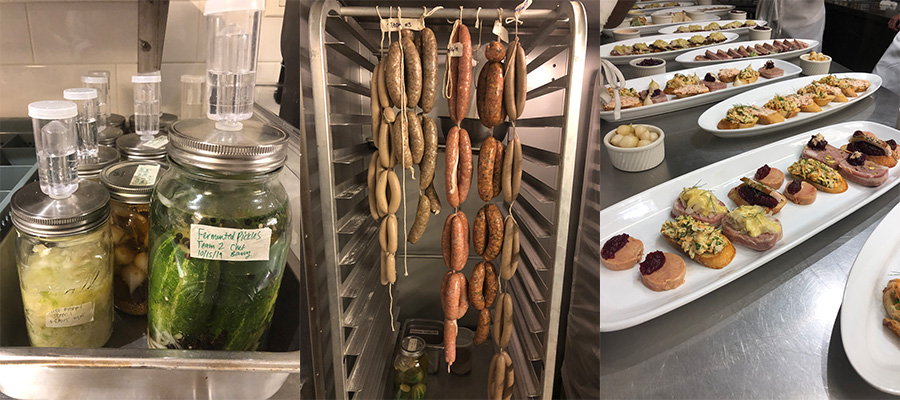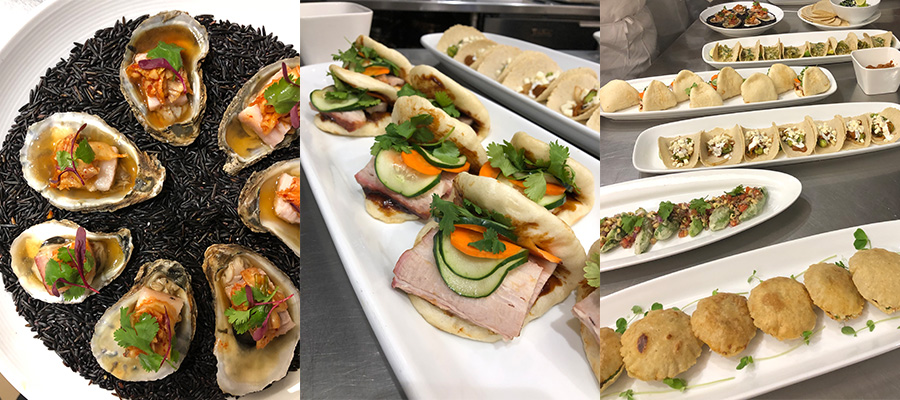Finally, we’re onto the fifth and final module and there is only a week of classes left. Ah! This module focuses primarily on garde manger, which refers to the cold station. We’ve touched on everything from hors d’oeuvres, canapés and pâtés, to terrines and charcuterie. Let’s just say, some were prettier than others.
It’s probably for the best that the pastry module is over because your body can only eat croissants for dinner for so long. This is a chapter in my culinary school diaries that I am ready to leave behind. One of the most immediate differences that our class noticed between Mod 5 and previous modules is the lack of food. I’m pretty sure there was not a single thing to eat during the first five lessons. Devastating, I know. This is because the first few classes were heavy on fermentation, pickling, curing, smoking and brining, so everything had to sit for at least a few days, some for a few weeks, before the desired final product was achieved.
How did I go from eating muffins and brioche for dinner to nothing?! My body is absolutely desperate for a normal routine and perhaps a vegetable, but I digress! When it finally came time to plate and serve all of the various items that we’d been working on, it felt all the more worthwhile. For what it’s worth, I still think frequently about the duck pastrami.

We made bacon, gravlax, kimchi, pickles, hot sauce and yogurt, to name a few. Everything felt like a fun science project, the best part being that you can eat it in a few days. What a thrill! If you’ve never made homemade sauerkraut, I highly encourage you to try it out. Not only does it require basic ingredients, it’s also incredibly simple and massaging the cabbage is a great way to get out any pent-up aggression. Therapy is expensive and cabbage is cheap. Don’t tell my therapist I said that.
During these classes, we also learned about sausage, chicken liver mousse and foie gras, which are all very delicious, but making them is anything but glamorous. Despite the irreversible damage that these classes have done to my eyesight (Have you ever seen the deveining of a foie gras lobe?), I will admit that I really did enjoy making sausages. Once you get past the fact that you’re literally grinding and blending up raw meat, fat, ice water and spices, only to squeeze them into edible hog casings, it’s pretty fun! These classes taught me the definition of a sausage, which is an emulsion of meat and fat (my previous definition was “mystery mixture of meats and spices that are jammed into mystery material), and emulsions are an important meat preparation technique for a variety of applications.
Despite the visual horror that was sausage-making, I did learn some useful tricks. Whenever you’re making a mixture of raw meats and spices, you typically want to check the seasoning before you proceed making your dish. Usually, to test the seasoning, I would throw a small sample of the meat mixture into a skillet with some oil and taste. Our chef pointed out that this technique is slightly misleading because when you sample your cooked meat, you’re getting flavor from the caramelization that’s happening while sautéing the meat. Instead, we were instructed to wrap a small bit of meat in plastic wrap and gently simmer it in water. Although the texture of this cooked meat is less than desirable, it really allows you to taste the meat for what’s actually in there and adjust your seasoning accordingly, if necessary. This doesn’t apply to just sausage making — try it out next time you’re making a batch of meatballs or a meatloaf.

One of the best days of this module is the hors d'oeuvres class. I am partially biased because the dish that I mostly worked on was David Chang’s recipe for oysters with kimchi consommé and pork belly (9-1-1, I’d like to report a flavor emergency!!!), so you could say that I was happy as a ... clam (just go with it). The rest of my classmates worked on other tasty dishes and in the end, there were platters upon platters of shishito pepper tacos, pork buns, plantain chips and empanadas. This definitely made up for the fact that we went hungry for the first half of the module.
Believe it or not, that pretty much wraps up all of the new material that we’ll learn during the Culinary Arts program! Now, we’re switching into review mode and market basket cooking. This is the moment we’ve all been waiting for: All of the lessons and techniques that I’ve learned along the way will be put to the test. Send positive vibes! Or croissants! I’ll be accepting both!
Make your way to Module 1 of ICE's Culinary Arts program.




